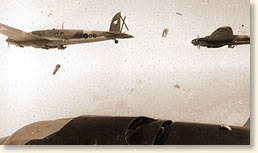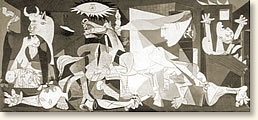|
The Bombing of Guernica, 1937
The German bombers appeared in the skies over Guernica in the late afternoon of April 26, 1937 and immediately transformed the sleepy Spanish market town into an everlasting symbol of the atrocity of war. Unbeknownst to the residents of Guernica, they had been slated by their attackers to become guinea pigs in an experiment designed to determine just what it would take to bomb a city into oblivion.
 |
The Condor Legion in action
over Spain, 1937 |
Spain was embroiled in a convulsive civil war that had begun in July 1936 when the right-wing Nationalists led by General Francisco Franco sought to overthrow Spain's left-wing Republican government. It did not take long before this bloody internal Spanish quarrel attracted the participation of forces beyond its borders - creating a lineup of opponents that foreshadowed the partnerships that would battle each other in World War II. Fascist Germany and Italy supported Franco while the Soviet Union backed the Republicans. A number of volunteers made their way to Spain to fight and die under the Republican banner including the Abraham Lincoln Brigade from the United States.
Hitler's support of Franco consisted of the Condor Legion, an adjunct of the Luftwaffe. The Condor Legion provided the Luftwaffe the opportunity to develop and perfect tactics of aerial warfare that would fuel Germany's blitzkrieg through Europe during 1939 and 1940. As German air chief Hermann Goering testified at his trial after World War II: "The Spanish Civil War gave me an opportunity to put my young air force to the test, and a means for my men to gain experience." Some of these experimental tactics were tested on that bright Spring day with devastating results - the town of Guernica was entirely destroyed with a loss of life estimated at 1,650. The world was shocked and the tragedy immortalized by Pablo Picasso in his painting Guernica.
Noel Monks was a correspondent covering the civil war
in Spain for the "London Daily Express." He was the first reporter to
arrive on the scene after the bombing. We join his story as he and other reporters
drive along a dusty Spanish road:
"We were about eighteen miles east of Guernica when Anton pulled to the side of the road jammed on the brakes and started shouting. He pointed wildly ahead, and my heart shot into my mouth, when I looked. Over the top of some small hills appeared a flock of planes. A dozen or so bombers were flying high. But down much lower, seeming just to skim the treetops were six Heinkel 52 fighters. The bombers flew on towards Guernica but the Heinkels, out for random plunder, spotted our car, and, wheeling like a flock of homing pigeons, they lined up the road - and our car.
Anton and I flung ourselves into a bomb hole, twenty yards to the side of the road. It was half filed with water, and we sprawled in the mud. We half knelt, half stood, with our heads buried in the muddy side of the carter.
After one good look at the Heinkels, I didn't look up again until they had gone. That seemed hours later, but it was probably less than twenty minutes. The planes made several runs along the road. Machine-gun bullets plopped into the mud ahead, behind, all around us. I began to shiver from sheer fright. Only the day before Steer, an old hand now, had 'briefed' me about being strafed. 'Lie still and as flat as you can. But don't get up and start running, or you'll be bowled over for certain.'
When the Heinkels departed, out of ammunition I presumed, Anton and I ran back to our car. Nearby a military car was burning fiercely. All we could do was drag two riddled bodies to the side of the road. I was trembling all over now, in the grip of the first real fear I'd ever experienced."
Monk and his fellow reporters drive on, traveling near Guernica where they can hear what they think may be the sounds of bombs. They continue to the city of Balboa, where after filling his report to London, Monk joins his colleagues for dinner. His story continues as his dinner is interrupted by the news from Guernica:
"...a Government official, tears streaming down his face, burst into the dismal dining-room crying: 'Guernica is destroyed. The Germans bombed and bombed and bombed.' The time was about 9.30 p.m. Captain Roberts banged a huge fist on the table and said: 'Bloody swine.' Five minutes later I was in one of Mendiguren's limousines speeding towards Guernica. We were still a good ten miles away when I saw the reflection of Guernica's flames in the sky. As we drew nearer, on both sides of the road, men, women and children were sitting, dazed. I saw a priest in one group. I stopped the car and went up to him. 'What I happened, Father?' I asked. His face was blackened, his clothes in tatters. He couldn't talk. He just pointed to the flames, still about four miles away, then whispered: 'Aviones. . . bombas'. . . mucho, mucho.'
 |
Guernica
Pablo Picasso's interpretation of the attack, 1937 |
...I was the first correspondent to reach Guernica, and was immediately pressed into service by some Basque soldiers collecting charred bodies that the flames had passed over. Some of the soldiers were sobbing like children. There were flames and-smoke and grit, and the smell of burning human flesh was nauseating. Houses were collapsing into the inferno.
In the Plaza, surrounded almost by a wall of fire, were about a hundred refugees. They were wailing and weeping and rocking to and fro. One middle-aged man spoke English. He told me: 'At four, before the-market closed, many aeroplanes came. They dropped bombs. Some came low and shot bullets into the streets. Father Aroriategui was wonderful. He prayed with the people in the Plaza while the bombs fell.'..
...The only things left standing were a church, a sacred Tree, symbol of the Basque people, and, just outside the town, a small munitions factory. There hadn't been a single anti-aircraft gun in the town. It had been mainly a fire raid.
...A sight that haunted me for weeks was the charred bodies of several women and children huddled together in what had been the cellar of a house. It had been a refugio."
References:
Noel Monks' account appears in: Monks, Noel, Eyewitness (1955); Thomas, Hugh, The Spanish Civil War (1977).
How To Cite This Article:
"The Bombing of Guernica, 1937," EyeWitness to History, www.eyewitnesstohistory.com (2005).
|






